Related Research Articles

Pleasanton is a city in Atascosa County, Texas, United States. The population was 8,934 at the 2010 census. Pleasanton's official motto is "The City of Live Oaks and Friendly Folks." It is part of the San Antonio-New Braunfels Metropolitan Statistical Area.
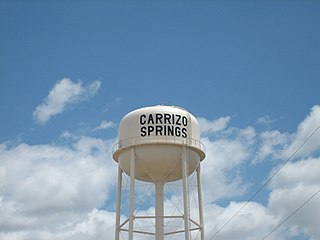
Carrizo Springs is a city in and the county seat of Dimmit County, Texas, United States. The population was 5,368 at the 2010 census..
Fowlerton is a census-designated place in La Salle County, Texas, United States. The population was less than 62 at the 2000 census. As of 2014, the town consisted of several streets criss-crossing at 90-degree angles and running several blocks each, but with only a handful of houses scattered among the entire network of roadways, with a number of these collapsed and uninhabitable. In their midst is a Baptist church. Across the highway stands a sturdy, two-story post office building, also a roadside cafe and a small farming-ranching supply business in more modest one-story quarters, comprising the entire nonresidential district.

George West is a city in Live Oak County, Texas, United States, and named for cattle rancher George Washington West. The population was 2,445 at the 2010 census. It is the county seat of Live Oak County. George West was named the "storytelling capital of Texas" in 2005 by the Texas Senate; and it hosts the George West Storyfest, a festival that features storytelling, cowboy poetry, and music. Numerous ranches surround George West.

Uvalde is a city in and the county seat of Uvalde County, Texas, United States. The population was 15,751 at the 2010 census.

Crystal City is a city in and the county seat of Zavala County, Texas, United States. The population was 7,138 at the 2010 census. It was settled as a farming and ranching community and was a major railroad stop being 110 miles (180 km) from San Antonio. Spinach became a major crop and the city has promoted itself as "Spinach Capital of the World." During World War II, a large internment camp was located here. The town is also noteworthy in the history of Mexican American political self-determination for the founding of the La Raza Unida Party.

Corpus Christi, colloquially Corpus, is a coastal city in the South Texas region of the U.S. state of Texas. The county seat of Nueces County, it also extends into Aransas, Kleberg, and San Patricio Counties. It is 130 miles southeast of San Antonio. Its political boundaries encompass Nueces Bay and Corpus Christi Bay. Its zoned boundaries include small land parcels or water inlets of three neighboring counties.

The Nueces River is a river in the U.S. state of Texas, about 315 miles (507 km) long. It drains a region in central and southern Texas southeastward into the Gulf of Mexico. It is the southernmost major river in Texas northeast of the Rio Grande. Nueces is Spanish for nuts; early settlers named the river after the numerous pecan trees along its banks.

The Missouri Pacific Railroad, commonly abbreviated as MoPac and nicknamed The Mop, was one of the first railroads in the United States west of the Mississippi River. MoPac was a Class I railroad growing from dozens of predecessors and mergers, including the St. Louis, Iron Mountain and Southern Railway (SLIMS), Texas and Pacific Railway (TP), Chicago and Eastern Illinois Railroad (C&EI), St. Louis, Brownsville and Mexico Railway (SLBM), Kansas, Oklahoma and Gulf Railway (KO&G), Midland Valley Railroad (MV), San Antonio, Uvalde and Gulf Railroad (SAU&G), Gulf Coast Lines (GC), International-Great Northern Railroad (IGN), Kansas, Nebraska & Dakota Railroad, New Orleans, Texas and Mexico Railway (NOTM), Missouri-Illinois Railroad (MI), as well as the small Central Branch Railway, and joint ventures such as the Alton and Southern Railroad (AS).
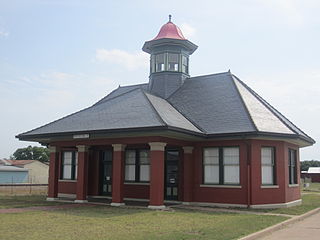
The International – Great Northern Railroad (I&GN) was a railroad that operated in the U.S. state of Texas. It was created on September 30, 1873, when International Railroad and the Houston and Great Northern Railroad merged. The railroad was officially incorporated as the International & Great Northern Railroad Company.
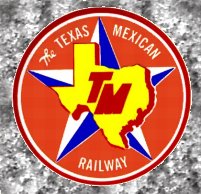
The Texas Mexican Railway is a railroad that operates as a subsidiary of the Kansas City Southern Railway in Texas. It is often referred to as the Tex-Mex, or TexMex Railway.
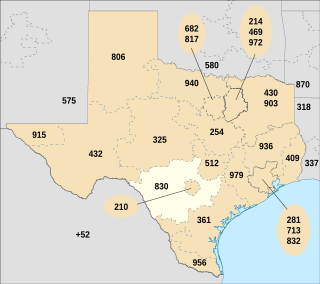
Area code 830 is the telephone area code in the North American Numbering Plan (NANP) for the portion of the U.S. state of Texas surrounding and to the west of the city of San Antonio. It was created July 7, 1997, in a split from numbering plan area 210, which was reduced to most of San Antonio, with a few outer portions of the city moving to 830. This split occurred only five years after 210 split from 512. However, San Antonio's rapid growth and the proliferation of cell phones and pagers forced the entire suburban ring around San Antonio into another area code within a short time.

The Corpus Christi Terminal Railroad is a terminal railroad originally created in 1924 to facilitate heavy bulk freight cargo traffic flow from the recently completed deep water port channel of the new Corpus Christi Port. Wishing to maximize freight handling potential while holding down rates, the Port Authority decided to allow traffic to all of its docks and facilities by no less than three competing railroads, the Southern Pacific, the Missouri Pacific and the Tex-Mex railroads. To accomplish this, the Port of Corpus Christi Authority built its own trackage along the channel and to the docks and allowed all three carriers access to it. While the Authority's scheme at first heightened tensions between the three railroads, they eventually began to cooperate, assuring a good flow of bulk freight and the eventual success of the Port facilities.
Article X of the Texas Constitution of 1876 covers railroad companies and the creation of the Railroad Commission of Texas. The federal government later created the Interstate Commerce Commission to regulate railroads, and eight of the nine sections of Article X were repealed in 1969 as "deadwood".
The following is a brief history of the North American rail system, mainly through major changes to Class I railroads, the largest class by operating revenue.
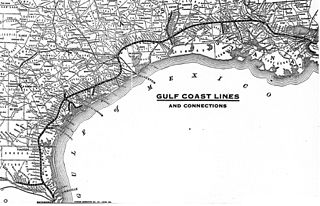
Chartered on June 6, 1903, the St. Louis, Brownsville & Mexico Railway was a 200-mile (321 km) U.S. railroad that operated from Brownsville, Texas, to Gulf Coast Junction in Houston, Texas. It served numerous towns and cities along its routes and operated a rail bridge between Brownsville and Matamoros, Tamaulipas, in junction with the Mexican government. The Brownie connected the citizens of Brownsville to nearby Corpus Christi for the first time on land rather than using water transportation.

The Gulf Coast Lines was the name of a railroad system comprising three principal railroads, as well as some smaller ones, that stretched from New Orleans, Louisiana via Baton Rouge and Houston to Brownsville, Texas. Originally chartered as subsidiaries of the Frisco Railroad, the system became independent in 1916 and was purchased by the Missouri Pacific Railroad in 1925.
The San Antonio and Aransas Pass Railway first began operation in the U.S. state of Texas in 1886. It was developed by Uriah Lott and businessmen of San Antonio as a direct route from the city to Aransas Bay on the Texas Gulf coast. It was eventually absorbed in the 20th century by Southern Pacific.
The Missouri and North Arkansas Railroad was a regional carrier from 1906 to 1946, which at its peak strength joined Joplin in southwestern, Missouri with Helena in Phillips County in eastern Arkansas.
References
- 1 2 3 4 5 6 "Nancy Beck Young, "San Antonio, Uvalde and Gulf Railroad Company"". Texas State Historical Association on-line. Retrieved April 28, 2013.
- 1 2 3 4 "Hugh Hemphill, "San Antonio Uvalde and Gulf Railroad"". txtransportationmuseum.org. Retrieved April 28, 2013.
- ↑ Not to be confused with the Gardendale in Ector County, Texas
- ↑ "Gardendale, TX (La Salle County)". tshaonline.org. Retrieved April 28, 2013.
- ↑ "Frank Kell". tshaonline.org. Retrieved April 28, 2013.